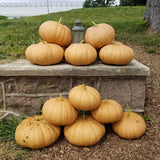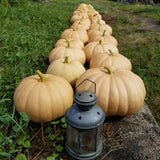Long Island Cheese Pumpkin
Cucurbita moschata
Shaped like a wheel of cheese, this ribbed, tan-skinned, long-storing winter squash has delicious deep-orange or "burnt sienna" flesh that is "dense, sweet, earthy, and savory." Two fruits per vine, 6-10 pound fruits.
According to our seed grower, Dorene Pasekoff, the Long Island Cheese Pumpkin is the best winter squash for the Mid-Atlantic region. She adds: "excellent flavor (traditional pumpkin pie), keeps for over a year, solid stems (no vine borer!), and no matter what the weather throws at it (heat, drought, torrential rains), there is always a crop." Harvest when color is well developed and rind is hard. Cure for a week in a dry place in the sun. For long storage, keep cured fruits in a cool, airy, but relatively dark place. They should keep at least a year and often longer. It's good enough that you'll want to have a pie at Thanksgiving and keep eating them through Easter!
Slow Food USA lists this variety as a historically important variety in their Ark of Taste. They describe how in the 1800s, cookbooks and farmers' almanacs from towns on the Long Island Sound mentioned the Long Island Cheese Pumpkin as a local favorite. Introduced commercially by Bernard McMahon in 1807, it was promoted as the best pie pumpkin. By the 1960, seed companies and local farmers mostly stopped saving and sharing this heirloom. Ken Ettlinger grew up on Long Island in the 1950s, and by the 1970s he realized this regional variety was quickly disappearing and so he began saving their seeds. In 2012, thanks to Ken Ettlingers seed stewardship, Steph Gaylor of Invincible Summer Farms on Long Island, other local seed stewards, and Ken Green of Hudson Valley Seed Company were able to start the Long Island Regional Seed Consortium to help preserve this important variety.
Slow Food adds that "it is very versatile and most parts of the plant are edible – shell, flesh, seeds, and flowers. Ripe flesh can be boiled, baked, steamed, pickled, or roasted, and enjoyed in soups, purees, desserts, preserves, pasta, and stews."
Days to maturity: 100
Seeds per pack: 30
Germination rate: 98% on 12/16/2025
Planting / harvesting notes
Direct sow in warm soil after the last frost, or seed indoors 2-3 weeks beforehand and transplant. Plant 3 seeds per hill spaced several feet apart, or seed in rows, one plant every 2-3 feet. Vines grow at least 10' if not much longer, so allow them space to sprawl. If grown in corn, you may need to train them so they won't pull it down! Avoid downy mildew by watering only at the base of the plant (not on the leaves!). Harvest when the stem begins to turn brown and woody and the fruit becomes hard, leaving a couple/few inches of stem. Cure in a dry or sunny place for a week, and then store in a cool (45-50 degrees) room for up to 5 months (however, keep an eye on it and use it at earliest sign of softening if not before).
Seed keeping notes
Squash is insect pollinated and requires about 1/2 a mile of isolation from other varieties of the same species, which in this case is C. moschata. The seeds will be fully mature on any squash when the stem of the fruit has turned brown and woody, so when you eat your squash, the seeds should also be ready for harvest. Separate the seeds from the flesh, rinse them, and dry them on a screen or paper product away from direct sunlight in a ventilated place. The plumpest and hardest seeds will be most viable.







